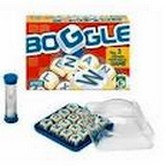Board Games Boggle

Board Games Boggle has been referred to as the poor man's Scrabble. It shares the same characteristics as Scrabble in that it is a word game that inspires and prompts player to put letters together to form words. However, it also has
core differences from Scrabble that make it unique as a word game and as a learning tool.
Perhaps the greatest difference between the two word games is that Scrabble is a slow game in comparison to Boggle, which in contrast darts along at a rapid pace. Boggle has
a great little three minute timer that pressures players to generate as many words as possible in a short window of time.
It is the combination of brainstorming and creative word play that makes Boggle such a wonderful educational tool. For speech
pathologists and other educators who work in short sessions, Boggle is a tremendously effective tool for generating language
skills and word learning skills in children quickly and easily.
Board Games Boggle - How to Play Boggle
Boggle consists of a tray which contains sixteen six-sided dice which feature letters on them. The dice rest in a plastic tray that
has a clear plastic lid on it. The dice are shaken while encased by the plastic lid. The dice settle to form a myriad number of short words. Players are required to identify as many words as they can within a three minute window of time.
The players can form words horizontally, vertically and diagonally. There are rules limitations in that no letter may be used twice within a single four letter words. So, for instance,
a combination that produced oils could not also use soils, because the letters has been used more than once.
Board Games Boggle - Educational Value of Boggle
By playing Boggle, children have the opportunity to learn spelling and vocabulary skills. In a typical game, which can be completed in a
20 min session, even a player with writing and spelling difficulties can discover and write down twenty to forty words. An added feature of Boggle is that players learn to spell words by identifying common spelling patterns and also learn to recognize spelling patterns that are not correct.
It is the pace of the game that makes Boggle such a great word learning activity. The number of words that a player can identify in Boggle
will far exceed the number of words that can be discovered in similar word games. Boggle also helps develop thinking skills and visuo-spatial skills as players rapidly sift through a pile of jumbled letters to form words.
Board Games Boggle - Additional Activities
There are a number of variations and forms of scaffolding that can be used with younger players. A simple variation is to allow younger players to create two letter combinations and three letter combinations. Another variation is for players to identify words
that are not adjacent to each other. This is a little more challenging but can produce some excellent results.
This rules variation is best used with players who are familiar and confident with playing Boggle.
For younger students and students with language and literacy problems, it helps to have an appropriate dictionary available so that correct and
incorrect word combinations can be checked to see that they are real words. It also helps develop good dictionary skills. It should be
stressed that it is ok for students to make spelling errors and produce incorrect combinations while playing Boggle.
Students should be encouraged to attempt any spelling combination they can form. Spelling rules can then be analysed as the word combinations players discover are discussed and a comparison between incorrect and correct spelling forms analyzed.
References
Brathwaite, B & Schreiber, I (2009) Challenges for Game Designers: Non Digital Exercises for Video Games Designers Course Technology CENGAGE Learning
Hinebaugh, J.P. (2009) A Board Game Education: Building Skills for Academic Success Rowman and Littlefield Education
Return from Board Games Boggle to Educational Board Games
Enjoy this page? Please pay it forward. Here's how...
Would you prefer to share this page with others by linking to it?
- Click on the HTML link code below.
- Copy and paste it, adding a note of your own, into your blog, a Web page, forums, a blog comment,
your Facebook account, or anywhere that someone would find this page valuable.
|